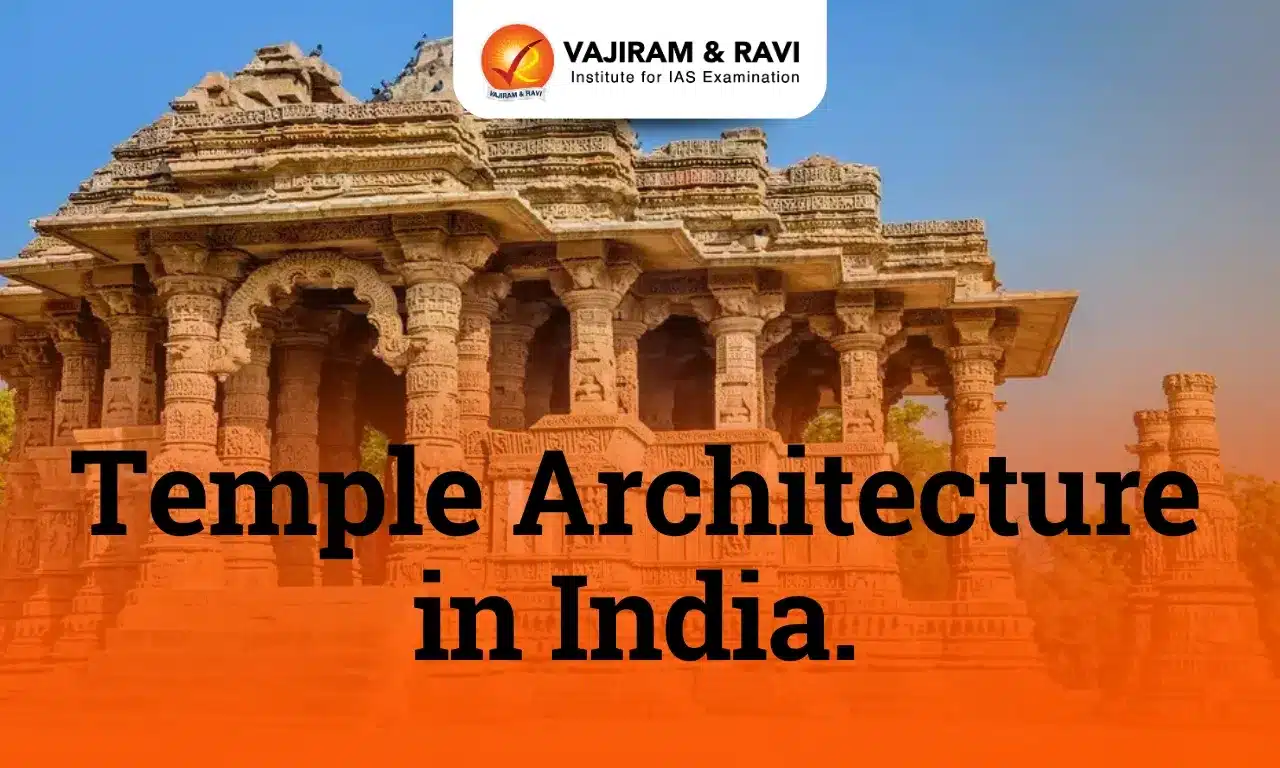The temple architecture in India has evolved over the ages as the style changed along with the changing dynasties and regions. It was in the 600–750 A.D. period that temple architecture crystallised into the Nagara style in the north and the Dravida style in the south. A fusion between the Nagara and Dravida styles, which emerged in the Deccan, eventually matured into the Vesara style in the post-750 A.D. period. While the architecture of Hindu temples varies from region to region, the major components of a temple remain constant. These components are garbhagriha or the sanctum, mandapa, shikhara, and vaahan.
The Basic Form of Temple Architecture in India
The basic form of the Hindu temple comprises the following:
- Garbhagriha (sanctum), which was a small cubicle with a single entrance, grew into a larger chamber in time.
- The garbhagriha is designed to house the major icon, which is the centre of much ceremonial attention.
- Mandapa: The entrance to the temple which may be a portico or colonnaded hall incorporates space for a large number of worshippers and is known as a mandapa.
- Shikhar: Freestanding temples tend to have a mountain-like spire, which can take the shape of a curving Shikhar in North India, and a pyramidal tower, called a vimana, in South India.
- Vahan: The mount or vehicle of the temple's principal deity, together with a typical pillar or dhvaj, is positioned axially before the shrine.
- Pradakshina Patha (Circumambulation): Around the garbhagriha, there is a circumambulatory path called the pradakshina patha.
- Dvarpals: Dvarpals are present in almost all the Hindu temples as well as in Buddhist and Jain temples in India. These semi-divine beings flank doors and entrances embodying the concept of door guardians found in these religions.
- Examples: Nagas, yakshas, Nandi, Chanda-Prachanda, the river goddesses Ganga and Yamuna and notable sages.
Types of Temple Architecture in India
Based on geographical location and architectural style, Hindu temples can be characterised under three broad categories—Nagara, Dravida, and Vesara style.The distinction can be made by comparing the elevation of the temple, the forms of the spire, and the plan of the temple.
- Nagara Style: The style of temple architecture that became popular in northern India is known as nagara.
- The Nagara style is not limited to a single time; it blossomed during the Gupta dynastyand continued to evolve throughout different regional kingdoms and empires that controlled northern India.
- Dravida Style: The style of the temple with different forms and features is seen in the South and it is known as the Dravida style.
- The Pallavaswere the pioneers of the Dravida style of architecture.
- Vesara Style: The Vesara style of temples is a combination of both Nagara and Dravida, its superstructure is bell-shaped.
- This style developed as a very florid architectural design in Chalukya (North & Central Karnataka), Hoyasala (South Karnataka), and Kakatiya (Hyderabad, Warangal, and surrounding districts) temples between the 7th and 13th centuries.
Nagara Style
The Nagara-style temple architecture is common in northern Indian temples, defined by the Garbhagriha, Shikhara (Curvilinear Tower), and Mandapa. In North India, temples are built generally on a stone platform with steps leading up to it. The plan of a Nagara-style temple is four-sided.
- Shikhara: While the earliest temples had just one tower or shikhara, later temples had several.
- There are many subdivisions of Nagara temples depending on the shape of the shikhara i.e., Rekha-Prasad or Latina, Phamsana, and Valabhi.
- Garbhagriha: The garbhagriha is always located directly under the tallest tower.
- Jagati: A Nagara temple generally rests on a high platform known as jagati over a small platform called pitha.
- Adhisthana: Rising above this is a smaller platform, which forms the base for the construction of the superstructure of the temple.
Temples during the Gupta Period
At its peak in the 5th century, the Gupta Empire developed a broadly unified genre of temples.
- Material: Gupta temples were made of brick or stone, with brick having taken the lead by the end of the Gupta period.
- Decorative Elements: Stone temples are extensively decorated with relief sculptures. All brick temples in the northern belt of Gupta influence are elaborately decorated with carved bricks and terracotta plaques.
- In eastern India, temples were initially decorated with stucco, which was later replaced by terracotta.
- First Phase: The earliest Gupta temples are modest, consisting of a square garbhagriha preceded by a flat-roofed, small portico.
- Second phase: It is assignable to the second half of the 5th century and is characterised by a jagati and an elaboration of the superstructure, particularly a roofed pradakshina around the garbhagriha.
- Examples: Parvati temple at Nachna Kuthara and the Shiva temple at Bhumara.
- Third Phase: It is distinguished by the presence of a towering shikhara over the garbhagriha.
- Example: The stone temple at Deogarh is a classic example of a late Gupta Period type of temple. This temple is in the panchayatana style of architecture where the main shrine is built on a rectangular plinth with four smaller subsidiary shrines at the four corners (making it a total number of five shrines, hence the name, panchayatana).
- Bhitargaon temple of Uttar Pradesh (contains the earliest version of the true arch in India) is a brick temple. Its shikhara, of a triratha plan, is one of the earliest examples of the Nagara style.
Temples of Khajuraho
The Khajuraho group of temples was built during the reign of the Chandelas between 900 CE to 1130 CE. These temples are free-standing as they are not enclosed within a wall.
- The most important characteristic feature of the Khajuraho temples is the balconied windows with sloping sunshades or chhajjas.
- Typical Nagara style and the largest temples in Khajuraho are the Kandariya-Mahadeva, Lakshmana, and Visvanatha temples.
- These temples have one main shrine and four subsidiary smaller shrines at its four corners standing on the same platform and they are called panchayatana temples.
- Each compartment or mandapa has its own shikhara. The grabha-griha of these temples is of sandhara type (without pradikshinapatha), with a plan called “Latin Cross”.
- Khajuraho’s temples are also known for their extensive erotic sculptures.
Temples of Orissa
In the 7th century A.D., Orissa emerged as a major centre of art and architecture, giving rise to a distinct regional style.
- Duel (Shikhara): In general, here the shikhara, called deul in Odisha, is vertical almost until the top when it suddenly curves sharply inwards.
- The main architectural features of Odisha temples are classified in three orders - rekhapida, pidhadeul, and khakra.
- Mandapa: The mandapa is called a jagamohana.
- Other features: Compartments and niches are generally square, the exterior of the temples are lavishly carved, and the temples have boundary walls.
- Example: Sun temple at Konark, constructed in the middle of the thirteenth century.
Temples of Gujarat
The Sun temple at Modhera is the best example of Nagara temple in Gujarat.
- It was built by Raja Bhimdev I of the Solanki Dynasty in 1026.
- In front of it is a huge rectangular stepping tank known as the Surya Kund.
- A huge ornamental arch-torana leads one to the sabha mandapa which is open on all sides.
- The elaborate carving and sculptural work reflect the Gujarati woodcarving tradition.
Dravidian Style
The Dravidian style of temple architecture flourished in south India from the 8th century to the 13-14th century A.D.
- Features:
- Vimana: In this style superstructure is a stepped vimana of six or eight sides with a round stupi (well-fashioned boulder) at its top.
- Shikhara: The Dravida temple has pyramidal shikhara, which consists of progressively smaller storeys.
- Gopurams: In a later stage, temples came to be marked by huge gateways known as gopurams and by pillared halls and corridors.
- Garbhagriha: The square inner sanctum is located within a massive covered enclosure.
- The temple is enclosed within a compound wall.
- The earliest evidence of such features dates back to the Gupta period and is not limited to the far south; for example, they can be found in northern and central India, as well as the Deccan.
Pallava temples
The Pallava dynasty held sway over Andhra Pradesh and northern Tamil Nadu between the 6th and 9th centuries A.D. At Mamallapuram, a pre-eminent Pallava cultural centre in Tamil Nadu, there are granite monuments of four distinct types. The two are most important, first, rock-cut monolithic shrines created out of single boulders of granite and second, structural temples built by piling stone upon stone.
- Pancha-Rathas at Mamallapuram: A group of five rock-cut shrines are located at the southern end of Mamallapuram. Four of them are named after the five Pandava heroes of the Mahabharata.
- The complex was initially thought to have been carved during the reign of Narasimhavarman I (630–668 CE.) However, historians such as Nagaswamy attributed all of the monuments in Mahabalipuram to Narasimhavarman II (690–725 CE).
- Shore Temple at Mamallapuram and Kailashanatha Temple at Kanchipuram: Built by Narasimhavarman II.
- Shore Temple: It consists of three separate worship areas, and there is a circumambulatory passage around the shrine.
- Kailashanatha Temple: Enclosed within a rectangular courtyard wall, the complex consists of the main temple and a series of miniature shrines. The main sandstone shrine, which has a separate hall and a pyramidal shikhara, is a full-fledged Dravidian temple.
Temples of Cholas
The Cholascontinued and developed the art tradition of the Pallavas and the Pandyas, whom they succeeded.
- The chief feature of a Chola temple is the vimana or the tower which was later eclipsed by the richly ornamented gopuram or gateway.
- Chola temples are considered in three phases.
- First Phase: The early Chola temples have square vimana with ardha-mandapa in the front and eight sub-shrines known as asta-parivaralya.
- Examples: Sundaresvara, Vijayalaya, Colesvaram, and the Koranganatha.
- Second phase: The architecture reached its zenith under the ruler Rajaraja I and his son Rajendra I. The temples were decorated with exquisite sculptural ornamentation.
- Example: The Brihadisvara temple at Thanjavur was built of large granite stones. It has the tallest vimana of 66m through sixteen storeys.
- Third phase: In this phase, additional pillared mandapas were built within the temple complex. Some of them are in the shape of a ratha or wheeled chariot drawn by elephants and horses.
- Example: Airavatesvara temple at Darasuram.
Vesara Style
This style of temple architecture mainly evolved, practised, and developed by the influence of the Chalukyas of Kalyani.
- Vimana: In the beginning had flat or slightly inclined rooftops while during later phases, a tower-like structure (Vimana) appeared.
- Mandapa: Pillared Mantapa was added to the four-walled Garbhagriha.
- Towers: Transformation of the Dravida towers by reducing the height of every floor and arranging them in a declining sequence of height from base to top.
- Additional adjustments include the vertical shape of the tower rather than an inclined storey as in the Nagara tower.
Temples of Western Chalukyas
There is great diversity among the structural temple forms of the Chalukyas of Kalyani. They are created by piling large blocks of stone. The joints between different units of a structure are visible.
- Mandapa: The interiors of mandapas are frequently carved with rich ceiling panels.
- Ornamentation: Walls of larger temples are embellished with vyala motifs and sometimes other floral and figural motifs.
- The shape of the temple: The Chalukyan pillars are square and heavy, without a base.
- They are decorated with mithunas, yakshinis and river goddesses Ganga and Yamuna.
- Sculptural Decoration: On the whole, sculptural decoration plays a much greater role in carrying out the programme of the temple than it did in the Gupta and immediatelypost-Gupta monuments.
- Examples: Meguti temple at Aihole, Durga temple at Aihole, Lad Khan temple at Aihole and Virupaksha temple at Pattadakal.
Rashtrakutas
The Rashtrakutasbuilt rock-cut shrines and temples at Ajanta, Ellora, and Aurangabad. Elephanta Cave is also a Rashtrakuta contribution.
- Kailasha temple at Ellora: The colossal and richly carved Kailasha temple complex at Ellora was constructed during the reign of Krishna I (757–83 CE) of the Rashtrakuta dynasty.
- This is the largest rock-cut monument in India and marks the culmination of rock architecture in South Asia.
Temples of Hoysalas
The Hoysalasruled over the Mysore plateau in the 12th and 13th centuries.
- Star-Shaped Temples: Their temples are extremely complex with so many projecting angles emerging from the previously straightforward square temple, that the plan of these temples starts looking like a star, and is thus known as a stellate-plan.
- Use of soft stone: Since they are made out of soapstone which is a relatively soft stone, the artists were able to carve their sculptures intricately.
- This can be seen particularly in the jewellery of the gods that adorn their temple walls.
- Example: The Hoysaleshvara temple (Lord of the Hoysalas) at Halebid in Karnataka was built in dark schist stone by the Hoysala king in 1150.
- Usually, these temples stand in an enclosure with a usual garbha-griha fronted by an antrala and a pillared mandapa known as navrang/gudha-mandapa.
Temple Architecture UPSC PYQs
Question 1: The Nagara, the Dravida, and the Vesara are the (UPSC Prelims 2012)
- three main racial groups of the Indian subcontinent
- three main linguistic divisions into which the languages of India can be classified
- three main styles of Indian temple architecture
- three main musical Gharanas prevalent in India
Answer: (c)
Question 2: Building ‘Kalyaana Mandapas’ was a notable feature in the temple construction in the kingdom of (UPSC Prelims 2019)
- Chalukya
- Chandela
- Rashtrakuta
- Vijayanagara
Answer: (d)
Question 2: Chola architecture represents a high watermark in the evolution of temple architecture. Discuss. (UPSC Mains 2013)
Last updated on November, 2025
→ Check out the latest UPSC Syllabus 2026 here.
→ Join Vajiram & Ravi’s Interview Guidance Programme for expert help to crack your final UPSC stage.
→ UPSC Mains Result 2025 is now out.
→ UPSC Notification 2026 is scheduled to be released on January 14, 2026.
→ UPSC Calendar 2026 is released on 15th May, 2025.
→ The UPSC Vacancy 2025 were released 1129, out of which 979 were for UPSC CSE and remaining 150 are for UPSC IFoS.
→ UPSC Prelims 2026 will be conducted on 24th May, 2026 & UPSC Mains 2026 will be conducted on 21st August 2026.
→ The UPSC Selection Process is of 3 stages-Prelims, Mains and Interview.
→ UPSC Result 2024 is released with latest UPSC Marksheet 2024. Check Now!
→ UPSC Prelims Result 2025 is out now for the CSE held on 25 May 2025.
→ UPSC Toppers List 2024 is released now. Shakti Dubey is UPSC AIR 1 2024 Topper.
→ UPSC Prelims Question Paper 2025 and Unofficial Prelims Answer Key 2025 are available now.
→ UPSC Mains Question Paper 2025 is out for Essay, GS 1, 2, 3 & GS 4.
→ UPSC Mains Indian Language Question Paper 2025 is now out.
→ UPSC Mains Optional Question Paper 2025 is now out.
→ Also check Best IAS Coaching in Delhi
Temple Architecture FAQs
Q1. What are the earliest temples in India?+
Q2. What are the types of temple architecture in India?+
Q3. What are the basic features of temple architecture?+

















